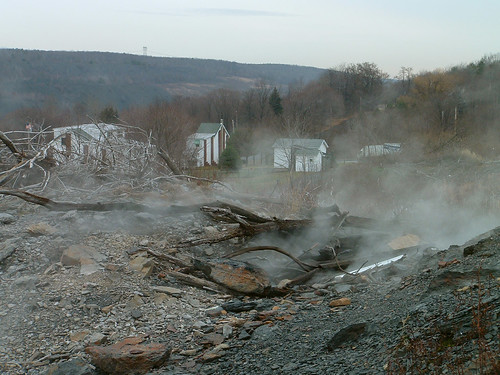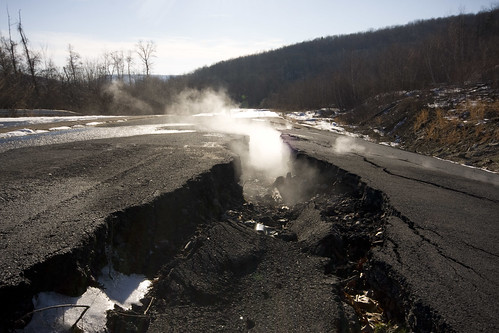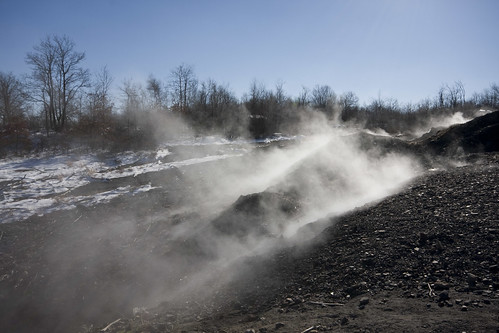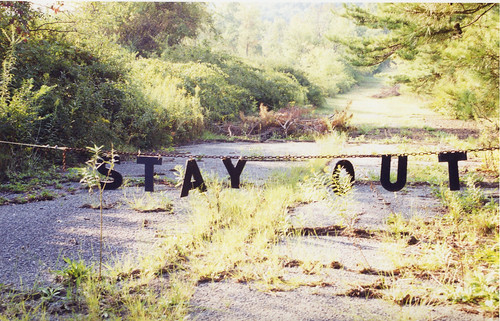On Valentine’s Day, 1981, eleven-year-old Todd Domboski was walking
through a field in Centralia, Pannsylvania, when a 150-foot-deep hole
suddenly opened beneath his feet. Noxious fumes crept out as the boy
fell in. He only survived by clinging to some newly exposed tree roots
until his cousin ran over and pulled him to safety. What was happening
here …and why?
COAL COUNTRY
Eastern Pennsylvania in anthracite coal country. Back at the turn of
the 20th century, miners were digging nearly 300 millions tons of coal
per year from the region, leaving behind a vast subterranean network of
abandoned mine shafts. In May 1962, while incinerating garbage in an old
strip mine pit outside of Centralia, one of the many exposed coal seams
ignited. The fire followed the seam down into the maze of abandoned
mines and began to spread. And it kept spreading -and burning- for
years.
Mine fires in coal country are actually not all that uncommon. There
are currently as many as 45 of them burning in Pennsylvania alone.
Unfortunately, there’s no good way to put them out. But that doesn’t
stop people from trying.
* The most effective method to extinguish such a fire s to strip mine
around the entire perimeter of the blaze. That’s an expensive -and in
populated areas, impractical- proposition. Essentially, it means digging
an enormous trench, deep enough to get underneath the fires, which are
often more than 500 feet below the ground.
* An easier (but not much easier) method is to bore holes down into
the old mine shafts, and then pour in tons of wet concrete to make
plugs. Then more holes are drilled and flame-supressing foam is pumped
into the areas between the plugs. It, too, is a very expensive project,
and it doesn’t always succeed.
The cheapest way to deal with a mine fire by far is to keep an eye on
it and hope it burns itself out. (One fire near Lehigh, Pennsylvania,
burned from 1850 until the 1930s.) After a 1969 effort to dig out the
Centralia fire proved both costly and unsuccessful, they admitted defeat
and let the fire take its course. By 1980, the size of the underground
blaze was estimated at 350 acres, and large clouds of noxious smoke were
billowing out of the ground all over town. The ground temperature under
a local gas station was recorded at nearly 1,000ºF. Residents of the
once-thriving mountain town began to wonder if Centralia was a safe
place to live.
When the boy fell in the hole and almost died, the fire beneath
Centralia became a national news story. The sinkhole -cause by an effect
known as subsidence, which occurs when mine shafts collapse,
possibly because the support beams are on fire- put the town’s 1,600
residents in a fix. Their homes were suddenly worthless. They couldn’t
sell them and move someplace safer -no one in their right mind would buy
them.
The townsfolk were given a choice: a $660-million digging project
that might not work, or let the government buy their homes. They voted
345 to 200 in favor of the buyout, and an exodus soon began. By 1991,
$42 million had been spent buying out more than 540 Centralia homes and
businesses.
GHOST TOWN
If you were to visit Centralia today, the first thing you’d notice is
that there are more streets than buildings. At first glance, it would
seem that someone decided to build a town, but only got as far as paving
the roads. If you looked a bit closer, however, you’d notice the
remnants of house foundations. Looking still closer, you’d see smoke
still seeping out of the ground.
As of 2005, twelve die-hard Centralians reportedly continue to live
in the smoldering ghost town. The number has dwindled since a decade
ago, when nearly fifty holdouts still called it home. Experts estimate
that it will take 250 years for the fire to burn itself out.





No comments:
Post a Comment